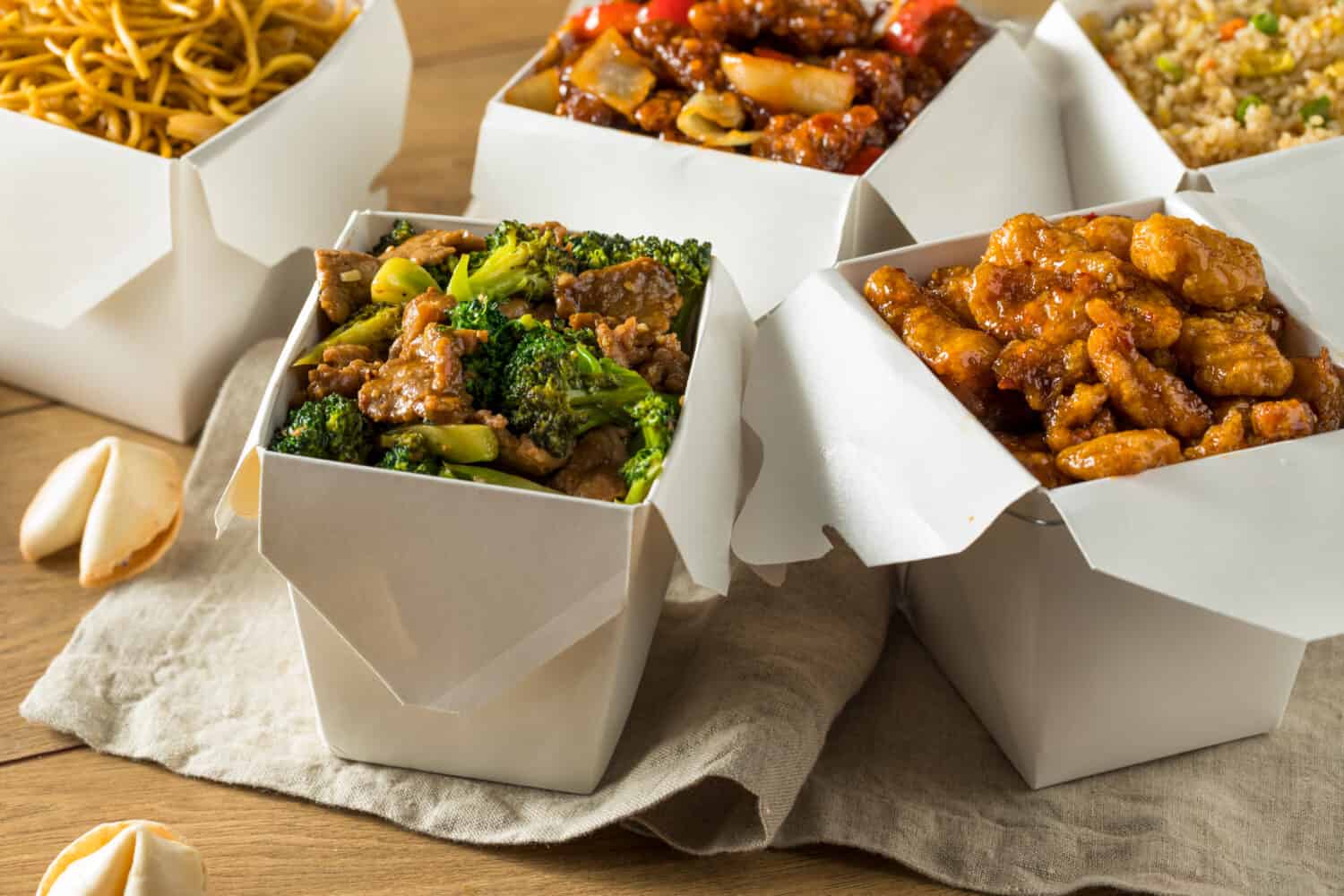Panda Express is a Chinese-American food chain that has been around since 1983. But is Panda Express actually healthy? This fast-food chain is known for its flavorful menu items. These include General Tso’s chicken, chow mein noodles, and a vivid orange chicken entree. However, Panda Express is a fast food restaurant. You’ll find a lot of sodium, carbohydrates, saturated fat, and calories in these tasty meals. They do have a “Panda Promise” initiative to offer lower-calorie, healthier food options. However, dietitians warn that more vegetables or brown rice don’t necessarily add up to the level of fiber. And that even the healthy meals offered still go over the recommended levels of sodium (via VeryWellFit).
So, it would seem that, as is the case with most fast food chains, Panda Express can be enjoyed with an awareness of what you’re eating. But it shouldn’t be necessarily depended upon as the model for healthy fast-food dining. Still, read on as we take a closer look at their menu offerings. While they offer the full restaurant dining experience, Panda Express also offers a drive-through. The drive-through menu is slightly smaller to-go. We’ll talk a bit about their history, and learn more about the “Panda Promise.” Stick around to see which menu options you should try to avoid while at Panda Express, and anything else you may want to know before dining. So, is Panda Express actually healthy?
The History of Panda Express
The first Panda Express restaurant was called Panda Inn, and it opened in Pasadena, California in 1973. It was started by Andrew Cherng and his father, Chef Ming-Tsai Cherng. Panda Inn offered an upscale restaurant experience serving a blend of Mandarin and Szechwan-style dishes. The Panda Restaurant Group Inc. started the fast-food version of this style of cooking and called it “Panda Express.” In 1983, the first location opened in the Glendale Galleria. Originally Panda Express could only be found within the State of California (via DigLab).
In 1987, the signature “Panda Express Orange Chicken,” dish was conceived by Chef Andy Kao. From there the restaurant chain continued to innovate. By 1993, they had 100 locations around California. They would go on to open drive-throughs, and stadium locations as well. The restaurant's menu continued to expand, and in 2009, the first Wok Smart™ menu items showed up. These offer items with 300 calories or less with at least 8 grams of protein. Panda Express went international in 2011, with a restaurant in Mexico City. They have since spread throughout the States, into Mexico, Canada, the United Arab Emirates, and South Korea (via Panda Express).
Nutritional Breakdown of Panda Express
Now that we've covered some of the history of this fast-food chain, let's take a look at its health initiative. The Panda Promise includes the Wok Smart™ menu which offers meals with 8 grams of protein with under 300 calories. More than half of their entrees are included in this category, and they're packed with vegetables.
The initiative details how Panda Express is working to decrease its sodium and sugar levels, as well as cutting out artificial flavorings and colorings by 2025. In 2021, they cut out high-fructose corn syrup from any meals. They use chicken meat from chickens raised without antibiotics, and eggs that are supplied with the highest level of food regulations.

The chickens used for Panda Express meals are free of antibiotics, and the eggs are of high quality.
©Moonborne/Shutterstock.com
Another handy feature of the Panda Promise is the nutrition page on their website. This offers a nutritional breakdown of all their menu options. The disclaimer at the top states what allergens are included, and that there is no MSG unless it's already naturally in certain ingredients before use.
Healthy Food Options at Panda Express
The Panda Express menu offers several different types of meals. This can be good to know so that you can customize options for healthier alternatives. They have a bowl which is an entree and a side dish, or a plate which includes two entrees, and a side dish. The bigger plate is one side and three entrees, while the family meal is three large entrees and two large sides. If you're picking a healthier entree, match it up with a few healthy sides instead of just picking the classics.
According to Eat This Not That!, with insight from a nutritionist, the best entrees include the chicken teriyaki with 340 calories, 13 grams of fat, 14 grams of carbohydrates, and 41 grams of protein. There are about 10 grams of sugar in the sauce, along with 630 milligrams of sodium, which isn't overkill. There's also the string bean chicken breast which packs 12 grams of protein, 210 calories, 12 grams of fat, and 13 grams of carbs. You'll get a sodium dose of about 560 milligrams, 5 grams of fiber, and 5 grams of sugar with this option.
The broccoli beef entree only has 150 calories, with 13 grams of carbohydrates, and 9 grams of protein. It contains 520 milligrams of sodium, 2 grams of fiber, and 7 grams of sugar. The black pepper Angus steak only has 210 calories, with 19 grams of protein, and the mushroom chicken has 13 grams of protein with 220 grams of carbohydrates. Adding healthy sides like super greens and brown rice will up the nutritional content of all of these dishes.
What to Avoid Panda Express, From a Health Perspective
In terms of the less healthy options at Panda Express, sadly a couple of their fan-favorite dishes are solidly on this list. The Beijing beef, which was introduced in 2008 on the restaurant's 25 anniversary has a whopping 480 calories, 27 grams of fat, and 600 milligrams of sodium. The orange chicken has 440 calories, 22 grams of fat, and 810 milligrams of sodium. While both of these provide some protein, the sodium counts aren't totally worth the protein. Their classic chow mein dish contains 510 calories, 20 grams of fat, and 860 milligrams of sodium, the highest amount so far.

While iconic and delicious, this oh-so-sweet and vivid Panda Express dish is not among its healthiest.
©Alexander Prokopenko/Shutterstock.com
Yet another menu favorite, the honey walnut shrimp, which debuted in 2010 has 260 calories, 24 grams of fat, and 590 milligrams of sodium. And lastly, the sweet and sour chicken breast, which doesn't have a whole lot of sodium (260 milligrams,) and stays below the 300 mark for calories, does have 24 grams of sugar in the sauce (via Eat This Not That!). The takeaway should be that some of the tastiest items on the Panda Express menu should be eaten in moderation or as a real treat. Because they don't deliver the right balance of sodium, carbohydrates, sugar, or fat-to-protein ratio for a good quality meal.
In Summary: Is Panda Express Actually Healthy?
So, is Panda Express actually healthy? The fast food chain is making efforts to provide healthier food options to its customers. However, it's still not the healthiest meal option. There are definitely routes for customizing combinations to supply a balance of healthy carbohydrates, fats, and protein. But it's the sodium levels and sugar in lots of the tastier sauces that get this fast-food chain into trouble. The handy nutrition chart on their website is a useful tool for ordering. And perhaps there is a “best combination,” of the healthier and unhealthier options. There are definitely ways to get your fix of tasty American-Chinese food while getting some good protein or carbohydrates.
It'll be interesting to see how the “Panda Promise” plays out in 2025. Panda Express is working to decrease sodium and sugar levels, as well as artificial colors and flavorings. They're taking steps, but in the meantime, enjoy your Panda Express in moderation, and use the nutritional chart when in doubt to track what you're putting in your body.
The image featured at the top of this post is ©Brent Hofacker/Shutterstock.com
